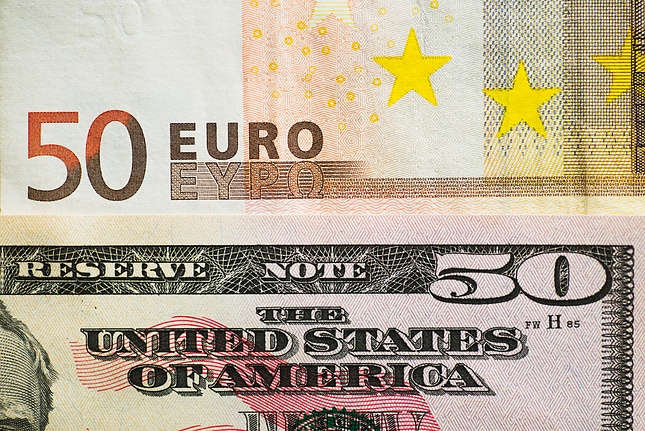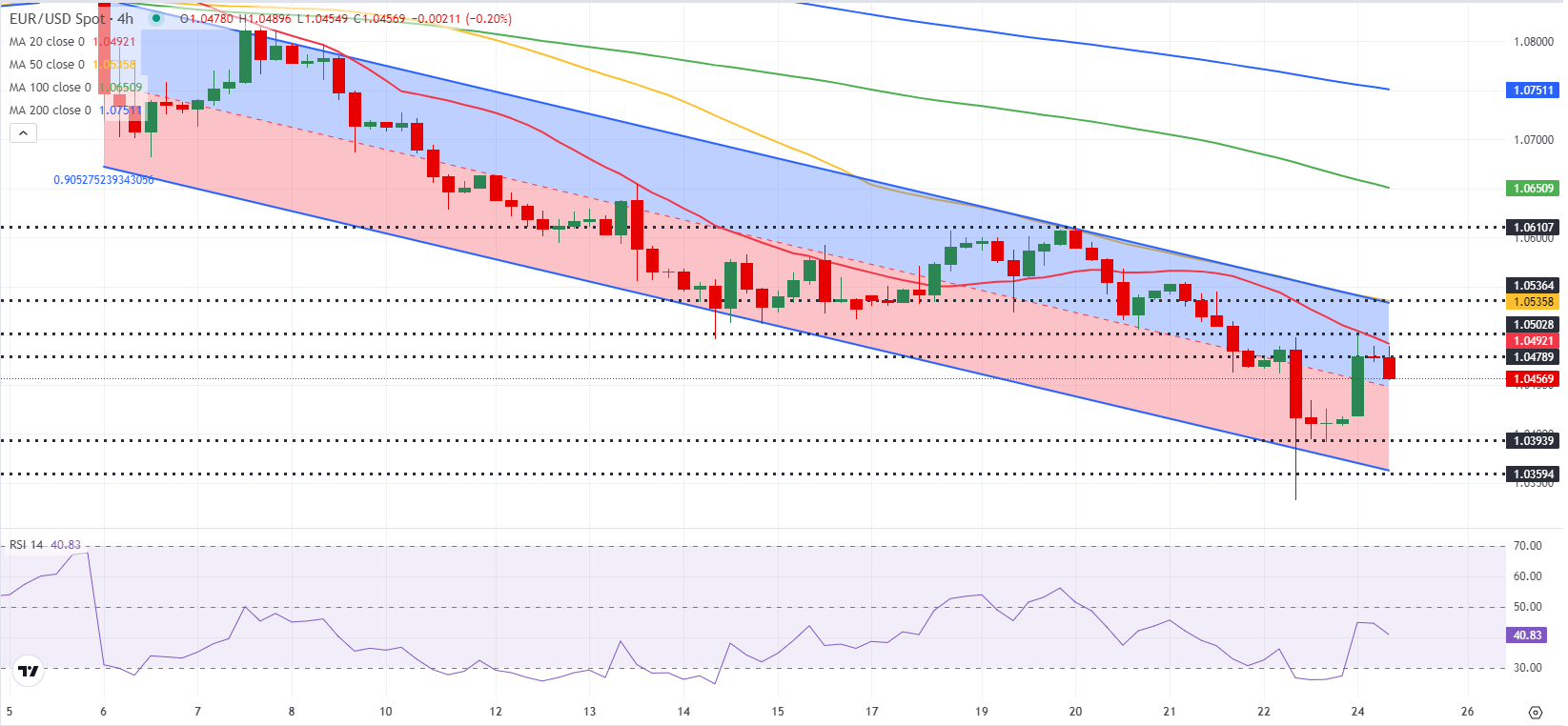- EUR/USD opened higher after closing the previous week deep in the red.
- The technical outlook is yet to point to a buildup of bullish momentum.
- Improving risk mood could help the pair stretch higher.
EUR/USD lost more than 1% for the third consecutive week but opened with a bullish gap on Monday. The pair, however, retreats slightly after testing 1.0500 and the technical outlook shows a lack of bullish momentum.
Euro PRICE Today
The table below shows the percentage change of Euro (EUR) against listed major currencies today. Euro was the strongest against the US Dollar.
| USD | EUR | GBP | JPY | CAD | AUD | NZD | CHF | |
|---|---|---|---|---|---|---|---|---|
| USD | -0.30% | -0.36% | 0.29% | 0.08% | -0.05% | 0.17% | -0.05% | |
| EUR | 0.30% | -0.23% | -0.02% | -0.21% | 0.17% | -0.12% | -0.33% | |
| GBP | 0.36% | 0.23% | 0.21% | 0.02% | 0.42% | 0.12% | -0.10% | |
| JPY | -0.29% | 0.02% | -0.21% | -0.20% | 0.09% | -0.05% | -0.15% | |
| CAD | -0.08% | 0.21% | -0.02% | 0.20% | 0.02% | 0.10% | -0.16% | |
| AUD | 0.05% | -0.17% | -0.42% | -0.09% | -0.02% | -0.28% | -0.50% | |
| NZD | -0.17% | 0.12% | -0.12% | 0.05% | -0.10% | 0.28% | -0.22% | |
| CHF | 0.05% | 0.33% | 0.10% | 0.15% | 0.16% | 0.50% | 0.22% |
The heat map shows percentage changes of major currencies against each other. The base currency is picked from the left column, while the quote currency is picked from the top row. For example, if you pick the Euro from the left column and move along the horizontal line to the US Dollar, the percentage change displayed in the box will represent EUR (base)/USD (quote).
News of president-elect Donald Trump nominating fund manager Scott Bessent as the US Treasury Secretary caused US Treasury bond yields to decline sharply at the weekly opening, making it difficult for the USD to find demand.
Assessing Bessent's nomination, "Bessent, a hedge fund CEO, is known to be a fiscal hawk, so this should ease some of the more extreme deficit fears as he has advocated a 3% deficit by 2028," said Deutsche Bank analysts. "In practise that will be extremely tough but for now the market can be a bit relieved. He is also thought to be less extreme on trade policy than some of his rivals for the job."
In the meantime, US stock index futures are up about 0.5% in the European morning on Monday, highlighting a positive shift in risk mood. In case risk flows continue to dominate the action in financial markets after Wall Street's opening bell, the USD could come under renewed selling pressure and help EUR/USD extend its recovery.
The European economic docket will feature IFO - Current Assessment and IFO - Business Climate figures for November. A significant decline in these business sentiment data could limit the Euro's gains with the immediate reaction.
EUR/USD Technical Analysis
EUR/USD remains within a descending regression channel and the Relative Strength Index (RSI) indicator on the 4-hour chart stays below 50 despite the bullish opening to the week. On the downside, 1.0450 (mid-point of the descending channel) aligns as immediate support before 1.0400 (round level) and 1.0360 (lower limit of the descending channel).
Looking north, first resistance could be spotted at 1.0500 (round level, static level) ahead of 1.0535 (50-period Simple Moving Average (SMA), upper limit of the ascending channel) and 1.0600 (round level, static level).
Euro FAQs
The Euro is the currency for the 19 European Union countries that belong to the Eurozone. It is the second most heavily traded currency in the world behind the US Dollar. In 2022, it accounted for 31% of all foreign exchange transactions, with an average daily turnover of over $2.2 trillion a day. EUR/USD is the most heavily traded currency pair in the world, accounting for an estimated 30% off all transactions, followed by EUR/JPY (4%), EUR/GBP (3%) and EUR/AUD (2%).
The European Central Bank (ECB) in Frankfurt, Germany, is the reserve bank for the Eurozone. The ECB sets interest rates and manages monetary policy. The ECB’s primary mandate is to maintain price stability, which means either controlling inflation or stimulating growth. Its primary tool is the raising or lowering of interest rates. Relatively high interest rates – or the expectation of higher rates – will usually benefit the Euro and vice versa. The ECB Governing Council makes monetary policy decisions at meetings held eight times a year. Decisions are made by heads of the Eurozone national banks and six permanent members, including the President of the ECB, Christine Lagarde.
Eurozone inflation data, measured by the Harmonized Index of Consumer Prices (HICP), is an important econometric for the Euro. If inflation rises more than expected, especially if above the ECB’s 2% target, it obliges the ECB to raise interest rates to bring it back under control. Relatively high interest rates compared to its counterparts will usually benefit the Euro, as it makes the region more attractive as a place for global investors to park their money.
Data releases gauge the health of the economy and can impact on the Euro. Indicators such as GDP, Manufacturing and Services PMIs, employment, and consumer sentiment surveys can all influence the direction of the single currency. A strong economy is good for the Euro. Not only does it attract more foreign investment but it may encourage the ECB to put up interest rates, which will directly strengthen the Euro. Otherwise, if economic data is weak, the Euro is likely to fall. Economic data for the four largest economies in the euro area (Germany, France, Italy and Spain) are especially significant, as they account for 75% of the Eurozone’s economy.
Another significant data release for the Euro is the Trade Balance. This indicator measures the difference between what a country earns from its exports and what it spends on imports over a given period. If a country produces highly sought after exports then its currency will gain in value purely from the extra demand created from foreign buyers seeking to purchase these goods. Therefore, a positive net Trade Balance strengthens a currency and vice versa for a negative balance.
Information on these pages contains forward-looking statements that involve risks and uncertainties. Markets and instruments profiled on this page are for informational purposes only and should not in any way come across as a recommendation to buy or sell in these assets. You should do your own thorough research before making any investment decisions. FXStreet does not in any way guarantee that this information is free from mistakes, errors, or material misstatements. It also does not guarantee that this information is of a timely nature. Investing in Open Markets involves a great deal of risk, including the loss of all or a portion of your investment, as well as emotional distress. All risks, losses and costs associated with investing, including total loss of principal, are your responsibility. The views and opinions expressed in this article are those of the authors and do not necessarily reflect the official policy or position of FXStreet nor its advertisers. The author will not be held responsible for information that is found at the end of links posted on this page.
If not otherwise explicitly mentioned in the body of the article, at the time of writing, the author has no position in any stock mentioned in this article and no business relationship with any company mentioned. The author has not received compensation for writing this article, other than from FXStreet.
FXStreet and the author do not provide personalized recommendations. The author makes no representations as to the accuracy, completeness, or suitability of this information. FXStreet and the author will not be liable for any errors, omissions or any losses, injuries or damages arising from this information and its display or use. Errors and omissions excepted.
The author and FXStreet are not registered investment advisors and nothing in this article is intended to be investment advice.
Recommended Content
Editors’ Picks

EUR/USD holds above 1.0450 German sentiment data
EUR/USD stays in positive territory above 1.0450 after retracing a portion of its bullish opening gap. The data from Germany showed that the IFO - Current Assessment Index declined to 84.3 in November from 85.7, while the Expectations Index edged lower to 87.2 from 87.3.

GBP/USD pulls back toward 1.2550 as US Dollar sell-off pauses
GBP/USD is falling back toward 1.2550 in the European session on Monday after opening with a bullish gap at the start of a new week. A pause in the US Dollar decline alongside the US Treasury bond yields weighs down on the pair. Speeches from BoE policymakers are eyed.

Gold price manages to hold above $2,650 amid sliding US bond yields
Gold price maintains its heavily offered tone through the early European session on Monday, albeit manages to hold above the $2,650 level and defend the 100-period Simple Moving Average (SMA) on the 4-hour chart. Scott Bessent's nomination as US Treasury Secretary clears a major point of uncertainty for markets.

Bitcoin consolidates after a new all-time high of $99,500
Bitcoin remains strong above $97,700 after reaching a record high of $99,588. At the same time, Ethereum edges closer to breaking its weekly resistance, signaling potential gains. Ripple holds steady at a critical support level, hinting at continued upward momentum.

Eurozone PMI sounds the alarm about growth once more
The composite PMI dropped from 50 to 48.1, once more stressing growth concerns for the eurozone. Hard data has actually come in better than expected recently – so ahead of the December meeting, the ECB has to figure out whether this is the PMI crying wolf or whether it should take this signal seriously. We think it’s the latter.

Best Forex Brokers with Low Spreads
VERIFIED Low spreads are crucial for reducing trading costs. Explore top Forex brokers offering competitive spreads and high leverage. Compare options for EUR/USD, GBP/USD, USD/JPY, and Gold.
